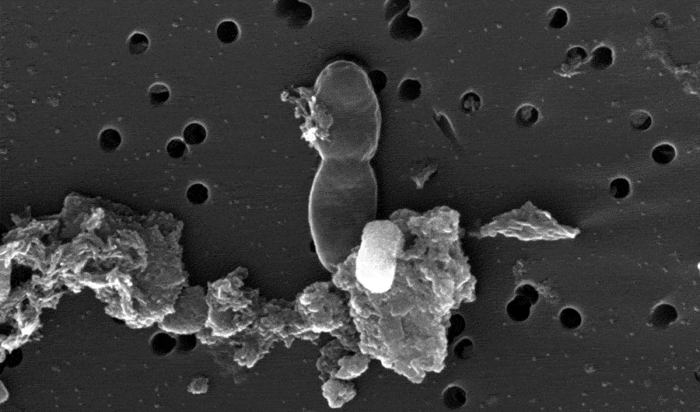Dec 19 2019
Sequestered Life
 Researchers may (and I emphasize “may”) have found life in isolated underground pockets of water in South African mines. What makes this potential find interesting is that this water has been isolated for about 2 billion years. Scanning electron microscopes have found what researchers believe may be a dividing bacterium. If this is confirmed it will be an exciting discovery for a few reasons.
Researchers may (and I emphasize “may”) have found life in isolated underground pockets of water in South African mines. What makes this potential find interesting is that this water has been isolated for about 2 billion years. Scanning electron microscopes have found what researchers believe may be a dividing bacterium. If this is confirmed it will be an exciting discovery for a few reasons.
But first – what do we know now? The water was collected from isolated pockets underground. The water is about 7 times as salty as sea water and can get up to about 54 degrees C. This is right at the limit for known extremophiles, but it is possible for bacteria or archaea to exist in these conditions. The evidence for possible life comes mainly from the microscopic images, which are suggestive but not definitive. One of the researchers, Devan Nisson, a graduate student, noted that “It’s possible the shapes were minerals.”
This would not be the first time that geological structures were confused for life. In 1996 researchers famously announced possible signs of life in a meteorite from Mars. Over 20 years later that claim is still not generally accepted. While there remains some controversy, the consensus is that the tiny structures are minerals, not microbes.
Making the claims for life in the South African mines at least plausible is the fact that there are nitrates and sulfates in the water, which could potentially be used by microbes as an energy source. There are abundant small organic acids, which could serve as building blocks and nutrients. So while extreme, it is possible that this water could support life.
In order to confirm actual life in the water researchers now need to do DNA sampling. If there are microbes living in the water, they will leave their DNA all over the place. Finding DNA will confirm that there is life there. Then they will need to examine the DNA to determine what kind of life. Even if there are signs of life, it is possible that the microbes are contaminants, introduced by drilling. The DNA would have to show that these microbes are new, not previously identified, and not similar to local microbial life.
Let’s say all this is confirmed – the researchers find DNA from bacteria or archaea and rule out contamination. What would this mean? What would be most exciting about this is that such microbes would have been isolated from the rest of life on Earth for 2 billion years. That’s 2 billions years of completely separate evolution. It’s even possible that such microbes won’t even be bacteria or archaea, but a new domain of life not previously identified. It is not inconceivable that such life might even represent a separate evolutionary origin of life. This would be super exciting, but also less likely.
It is entirely possible that life arose multiple times on the early Earth. The conditions were right, and there was plenty of raw material. Clearly one form of life dominated, and may in fact be the only branch of life to survive (if there even were others). But scientists acknowledge that there may be some bacteria-like organisms out there, even right under our noses, that have not been identified or examined and may be more different than any currently known life. Examining the DNA will be key.
What we might find if we examine DNA from very distant organisms is they have the identical genetic code to all other life on Earth, but have unique genes that indicate they branched off from all other life very long ago (2-3 billion years, for example). We may also discover life with a slightly altered genetic code (the pattern of which three nucleotides combinations code for which amino acids). Mitochondria, for example, use a slightly different genetic code than all other life, and this is the main evidence for the inference that mitochondria were separate organisms that began to live symbiotically with other cells. If a newly discovered microbe has a separate still genetic code, this would imply they branched off from all other life very early.
Most exciting would be to find organisms that have a completely different genetic code, completely randomized from the existing code. This would imply a completely separate origin, or a branching off so early it was before cells even developed, during the time of RNA evolution. Maybe even the basic setup of the code will be different, with different base pairs, or different number of letters (four instead of three) in the code. Evidence of a completely separate origin of life on Earth would affect our thinking about how likely life is in the universe.
The other implication of finding any life living in these deep salty and hot pools (regardless of their relation to other life on Earth) is just documenting the extreme conditions to which life can adapt. This would make it more plausible to find life living in isolated underground pockets of water on Mars.
Again – these findings are preliminary and suggestive only. The story may fizzle to nothing if life is not confirmed in the water, or if it is only contaminants. But if the researchers do confirm that a separate branch of life has been evolving in those pockets for 2 billion years in complete isolation, really interesting findings are sure to come out of that.






